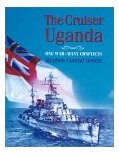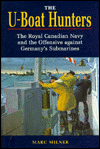Wings for Victory:
The Remarkable Story of the British Commonwealth Air Training Plan in Canada

by Spencer Dunmore,
ISBN: 0771029187
The Cruiser Uganda:
One War - Many Conflicts: The First Documented & Eyewitness Account of Canada's Only Cruiser in World War Two & Her Part in the Pacific War

by Stephen C. Geneja,
xii, 282 pages,
ISBN: 0969875401
Red Coats & Grey Jackets:
The Battle of Chippawa, 5 July 1814

by Donald E. Graves,
210 pages,
ISBN: 1550022105
The U-Boat Hunters:
The Royal Canadian Navy & the Offensive Against Germany's Submarines

by Marc Milner,
280 pages,
ISBN: 1557508542
Post Your Opinion | | Victory in Detail
by Robert StampHAVE THE VISUAL MEDIA commandeered military history? Do consumers still want written accounts of old battles when CNN's live, graphic coverage of the Gulf War remains forever etched in our collective consciousness? When television dramas like "The Valour and the Horror" excite veterans' groups far more than any mere book, or when unauthorized videos reveal more about the Canadian Airborne Regiment than any official written history dares tell'?
Consider my own recent visual encounters with the British Commonwealth Air Training Plan. Within a 24-hour period, I experienced two dramatic portrayals of this much lauded Canadian based program that trained 130,000 Commonwealth aircrew during the Second World War. At a Calgary movie theatre on a Friday evening, I watched For the Moment, a sensitive story about a love affair between an Australian trainee and a Prairie farm woman. The next afternoon in High River, Alberta, I applauded a sign-painter as he put the finishing touches to a large outdoor mural commemorating the local BCATP base from the early 1940s.
Spencer Dunmore's latest book, Wings for Victory: The Remarkable Story of the British Commonwealth Air Training Plan in Canada (McClelland & Stewart, 399 pages, $29.99 cloth), competes successfully with these filmmakers and mural-painters by putting romance and heroics in perspective and concentrating on the day-to-day details of training.
A retired advertising executive and author of several aviation novels, Dunmore first ventured into non-fiction with Reap the Whirlwind: The Untold Story of 6 Group, Canada's Bomber Force of World War II, a personalized look at men inaction and a healthy antidote to the administrative approach of The Crucible of War, 1939-1945, the official history of the RCAF overseas.
In Wings for Victory, he follows raw young recruits through their lengthy selection process and training regimen. Dunmore skilfully involves readers in the daily struggle of these young men to become pilots. navigators, gunners, bomb- aimers, or radio operators. We empathize with their lack of privacy, root for them in their occasional donnybrooks with local citizens (see Moose Jaw, Saskatchewan, September 1944), and applaud loudly when they receive their wings. By book's end, we are convinced that they are the world's best trained airmen who will help win the war in Europe.
Stephen Geneja's The Cruiser Uganda: One War -- Many Conflicts (Tyendinaga Publishcrs, 282 pages, $41.40 cloth) also succeeds by focusing on the minute details of servicemen's lives. Though lacking Dunmore's writerly skills, Geneja brings a first-person perspective as one of the Uganda's gunners. This is his own story, and he alone brought it to print. As he proudly boasts: "This book was written and printed without any financial assistance in any form from either government or private sources."
The HMCS Uganda was Canada's only naval cruiser in the Second World War and the only RCN ship in the Pacific. After initial service in the Mediterranean as a Royal Navy vessel, it was recommissioned as the HMCS Uganda, refitted and equipped with a Canadian crew, and joined the British Pacific Fleet off Okinawa in the spring of 1945 -just in time for kamikaze attacks by Japanese aircraft. (Later, during the Korean War, the Uganda was taken out of mothballs and recommissioned the HMCS Quebec.)
The author provides a seaman's-eye view of life aboard the Uganda's lower decks. We wake each morning to a bugle sounding "reveille," tumble out of our hammocks, endure cold showers with absolutely no privacy, form up for work parties, and take our turn on watch. Life is routine, life can be boring, although tension increases as the Uganda heads into the Pacific war zone for action against Japanese forces.
Illustrations and appendices contribute to the success of The Cruiser Uganda. Geneja includes dozens of candid photos of crew members at work and at play, excerpts from the ship's log, and maps of Pacific battle actions. He provides a valuable glossary of naval terms, a list of crew members, and follow-up stories of officers and men in the post-war world. While Geneja went on to enjoy a career as a county land registrar, the ship's commanding officer, Captain E. R. Mainguy, became chief of naval staff, and one of its radar officers, Lieut. John P. Robarts, served as premier of Ontario.
A historian with the Department of National Defence, Donald Graves is neither novelist nor combat participant, but his Red Coats and Grey Jackets: The Battle of Chippawa, 5 July 1814 (Dundurn, 2 10 pages, $18.99 paper) also brings military history to life by focusing on men in action.
The Battle of Chippawa often suffers in comparison with other War of 1812 skirmishes heroic struggles like Queenston Heights or bloodier carnages such as Lundy's Lane. Even so, 200 young men lost their lives in the battle. And after Chippawa, the British remembered not to "underestimate the fighting qualities of the American regular soldier," as they prepared for the battle at Lundy's Lane later in the month.
Graves sets the stage by introducing us to the officers and men of the "Grey Jackets: The Left Division, United States Army" and the "Red Coats: The Right Division, British Army in North America." He draws up these opposing forces on the Canadian side of the Niagara River in the summer of 1814. Skilfully integrating words, drawings, photographs, and maps, he takes these troops -- and his readers -- through the "scirmushing of the foornoon" and the afternoon battle's "scenes of indescribable horror." As added bonuses, Graves provides detailed appendices on individual participants and brings us up to date with the work of the recently formed Chippawa Battlefield Preservation Society.
Unfortunately, The U-Boat Hunters: The Royal Canadian Navy and the Offensive against Germany's Submarines (University of Toronto, 326 pages, $35 cloth), by Marc Milner, a University of New Brunswick historian, does not lend itself to such personalized accounts of men in action. Milner's earlier book, North Atlantic Run.- The Royal Canadian Navy and the Battle for the Convoys, focused on the years from 1941 to 1943, when the Battle of the Atlantic was at its height, and personal heroics were evident. Unfortunately, the 1943-45 period of The U-Boat Hunters sees submarine and anti-submarine warfare become more technical and abstract. How much excitement can be wrung out of acoustic torpedoes and snorkels, asdic and radar?
Milner further dehumanizes his story by taking us away from action in the North Atlantic and into the realms of political and administrative history. We learn much about the politics of the Department of National Defence, Royal Navy/Royal Canadian Navy rivalry, and the RCN's neglect of corvettes and the anti-submarine war in its desire to build a post-war balanced (read "big-ship") navy. A much more engrossing detour, however, might examine the idiosyncrasies of such characters as Captain J. D. "Chummy" Prentice, identified here as Canada's "most ardent U-boat hunter."
Jonathan Vance, a post-doctoral fellow at Wilfrid Laurier University, also focuses more on policy than lived experience in Objects of Concern: Canadian Prisoners of War through the Twentieth Century (UBC, 324 pages, $39.95 cloth). Since individual parts of this story have been told before -- Desmond Morton's Silent Battle: Canadian Prisoners of War in Germany, 1914-1919 and Daniel Dancocks's In Enemy Hands: Canadian Prisoners of War, 1939-45 -Vance opts for the comprehensive, all-inclusive approach. Unfortunately, military officials learned little over time; the Second World War meant only that problems "encountered earlier were repeated on a correspondingly larger scale."
Following advice from his doctoral supervisor, Vance refuses to get bogged down in the "realm of POW trivia." Instead, he takes the high road and concentrates on Canadian, Allied, and Axis policies. After brief wayside stops at Stalag Luft 3 and Hong Kong, that road leads to government and Red Cross offices in such exciting locations as Ottawa, London, and Geneva. The reader desperately longs for maps of camp layouts, escape routes, and tunnel diagrams -- in short, more POW trivia!
Finally, Arthur Bishop weighs in with his annual contribution to military history -- The Splendid Hundred: The True Story of Canadians Who Flew in the Greatest Air Battle of World War 11 (McGraw-Hill Ryerson, 170 pages, $19.95 paper). Bishop reminds those keeping score that Canadians in the Battle of Britain counted more victories per pilot than any other Allied group.
The son of the First World War air ace Billy Bishop, and a former Spitfire pilot himself, the author has difficulty progressing beyond the heroic approach to aerial warfare. In the end, however, he follows Dunmore, Geneja, and Graves into the lives and actions of ordinary participants, rather than into the morass of paper work favoured by policy historians. |